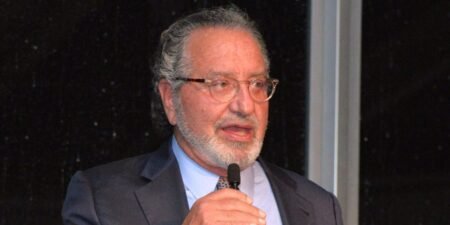- The West has long focused on producing expensive, powerful military equipment.
- But defense ministers warn that Russia has shown why more of the cheaper weaponry is needed.
- Denmark’s defense minister told BI it was “one of the lessons learned coming out from Ukraine.”
The Ukraine war has shown that fighting major, protracted conflicts demands more than exquisite weapons. It demands cheap weaponry in bulk.
The West has long prioritized developing and fielding the most expensive, sophisticated weaponry, but to confront near-peer rivals like Russia or China, it also needs cheap, throwaway weapons it can rapidly build a lot of, current and former NATO officials said.
Gabrielius Landsbergis, who until late last year was the foreign minister of Lithuania, a NATO ally next to Russia, described the war in Ukraine as one of “high quantities.” And there are important lessons in that.
He told Business Insider that while the West has focused on new weapons that are expensive and time-consuming to manufacture, the Russians are “building something that’s cheap, that’s expendable, that’s fast.”
Pål Jonson, Sweden’s defense minister, told BI that the US and Europe “are grappling with” the cost. He said that part of the problem is decades of underinvestment in weapons.
Insufficient and inconsistent demand often results in inefficient production, straining defense industries and triggering cost increases. Over time, industrial capacity is hollowed out, causing backlogs and shortages.
By ordering more, “we also expect a per unit price to fall,” Jonson said.
There’s a balance to all of this, as NATO Secretary-General Mark Rutte suggested last month. He said that “speed is of the essence, not perfection.” Rutte said it’s about “getting speed and enough quality done in the right conjunction.”
High-intensity conflicts chew up men and matériel, demanding quantity, not just quality, from armies. Cheaper weaponry has played a big role in Ukraine, where low-cost drones have destroyed pieces of weaponry worth millions. Russia has also turned to weapons like cheap drones and loitering munitions and glide bombs, reserving the more sophisticated precision-guided munitions for higher-value targets.
That’s not to say there isn’t value in the sophisticated systems. Ukraine has praised the American-made Patriot for its ability to stop weapons no other air-defense system can, but these weapons are few, take up to two years to make, and the interceptors cost around $4 million.
This isn’t the weapon for shooting down cheap drones.
Troels Lund Poulsen, the Danish defense minister, told BI the West needs far greater quantities of inexpensive weaponry to meet the threats posed by Russia and China. He said this is “one of the lessons” from Ukraine, which can produce cost-effective weapons and even achieve capabilities comparable to expensive Western systems.
The Russian defense ministry leadership has previously bragged that “our weapons are hundreds of times cheaper than the systems deployed to be used against us.”
China, likewise, has a large arsenal of cheap weaponry. A single missile barrage against the US Navy or key outposts in the Pacific could demand tens, if not hundreds, of millions of dollars in interceptors to repel.
War experts have warned that the US could quickly exhaust its supply of essential weapons in a war, which is why the US has been exploring how to build mass with cheaper drones, but it’s still a work in progress.
Lessons for the West
Russia’s invasion of Ukraine has much to teach Western countries that have spent decades fighting terrorists and insurgencies about what it’s like to fight a modern great-power war.
“We haven’t prepared for this,” Landsbergis said, adding that “we have been preparing for a different kind of war with high precision, high technology, very good aim, but also very expensive.”
These conflicts were less demanding. Russia, he said, changed that, and the Ukrainians are seeing it in real time.
The war in Ukraine is a grinding, attritional fight that is tearing through ammunition and weaponry. Russia, like China, has a lot of manpower and machinery to throw into the fight, which is very different from the US and NATO’s Global War on Terror.
An American military veteran who fought in Ukraine previously told BI the war is so different from other fights that some Western soldiers have been killed because they expected it to be easy and did not realize their training had not prepared them for this war.
Watching Ukraine, Western militaries are changing some of their priorities, reviving old tactics, like putting a greater emphasis on trench warfare, and exploring new ones, such as looking at the value of low-cost attritable systems like drones to augment their armed forces for future fights.
European leaders have pushed for more spending on defense as the Russians threaten to attack deeper into the continent and launch hybrid warfare attacks against NATO.
Landsbergis said Russia is “probably more dangerous than it has ever been. So if there was ever a time not to be complacent, it is now.” He said Europe needs to prepare because “the most dangerous times are up ahead.”
Lithuania’s defense spending is among the highest in NATO as a proportion of its GDP, and it, along with Estonia, has pledged to take that figure to 5%, a figure US President Donald Trump has advocated for while proposing stepping back from European defense.
Warfare experts and strategists previously told BI that how Russia is fighting shows that Europe and the US need to invest in a higher quantity of weapons instead of focusing solely on a smaller number of high-quality weapons.
Retired Australian Army Maj. Gen. Mick Ryan, a warfare strategist, said that “we just have not been stockpiling weapons” for a major, protracted conflict like the war in Ukraine, but “to be frank, Russia and China have been.'”
European defense spending has soared, though European leaders, as well as the head of NATO, stressed at the recent Munich Security Conference that more needs to be done.
The prime minister of Denmark, Mette Frederiksen, warned at the conference that European production issues urgently need to be addressed, telling gathered leaders that Ukraine was able to produce weaponry “faster and cheaper” than anywhere else in Europe even though it’s at war.
“We have a problem, friends, if a country at war can produce faster than the rest of us,” she said.
Read the full article here

















